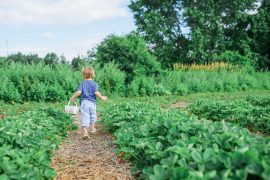By Alex Koster
I don’t know about you, but most of my childhood memories revolve around outdoor activities and adventures. We lived on the edge of a small rural village beside a forest and once we came home from school and our homework was done we went out the door to meet up with friends in the street to play games such as hopscotch and ballgames, or we’d just ride our scooters and bikes.
We’d head off to the stream to construct dams or build little rafts and let them sail away, collect frog spawn in the springtime and have a cooling splash around in the summer. We had many “secret” hiding places in the woods, we’d sneak out treats to have picnics in our treehouses and dens and go on imaginary adventures as pirates, cowboys or fairies.
In the winter-time we often had snow for weeks on end and I still remember the tingling feeling of numb hands, feet and noses when we’d come back into the warm house after hours spent in sub-zero temperatures building snowmen and igloos.
Whatever the weather we’d find something to do outdoors, even if it was building a shelter to hide from the pouring rain, the more muck and mess, the better!! As my PE teacher in school used to say: “There is no bad weather, only bad clothes.” We did have a television but we were only allowed to watch Sesame Street after our dinner and then we’d fall into bed happily exhausted.
Unfortunately, due to multiple circumstances children seem to spend less and less time outside. Richard Louv, the author of Last child in the Woods calls this modern-day occurrence “Nature-Deficit-Disorder”, a term which he points out is not an actual medical diagnosis. Schooldays are very long and especially in the winter there is barely any daylight left once homework is done. Living environments and conditions have changed considerably in the past 30-40 years, traffic has increased hugely and parenting is very different in comparison to how many of us parents and educators were brought up. Children don’t seem to get as much opportunity to play and “socialise” independently anymore, meeting friends is usually organised and supervised in “play dates” rather than children arranging their own meet-up.
Times have changed and there is nothing we can do about that, but we still have to make sure that our children can spend time outdoors as much as possible. It is vital for their physical and emotional development and well-being and it can actually be detrimental to children’s health if they don’t get enough outdoor time and experiences.
Outdoor activities ensure that children are physically active and their immune systems are strengthened by encountering myriads of microorganisms and trace amounts of pathogens. Safe exposure to the sun encourages Vitamin D production and it is scientifically proven that natural daylight is essential to prevent short sightedness to name just a few health benefits.
Herbert Renz-Polster, a paediatrician and scientist, and Gerald Huether, a professor for neurobiology, speak right from my heart, when they say that for children and their development nature is not “optional”, it’s as essential as a healthy diet for growing up. Only in nature and the outdoors do they encounter all four non-negotiable sources for their development: freedom, immediacy, resistance and relatedness (connection).
See next page for more…











